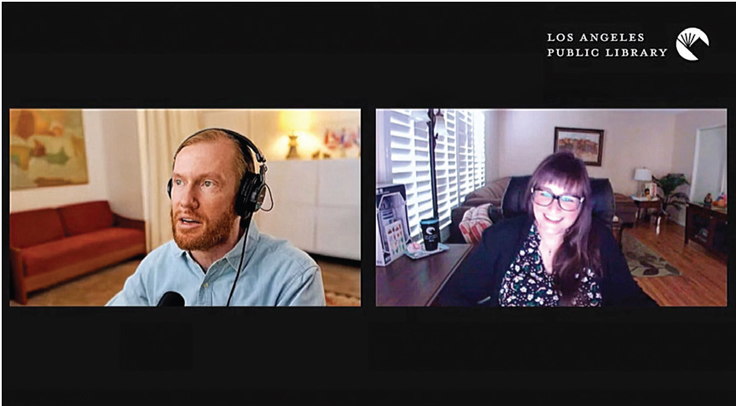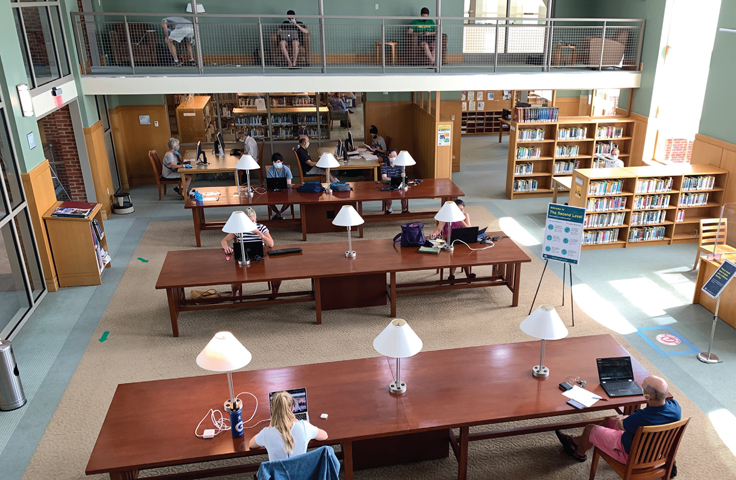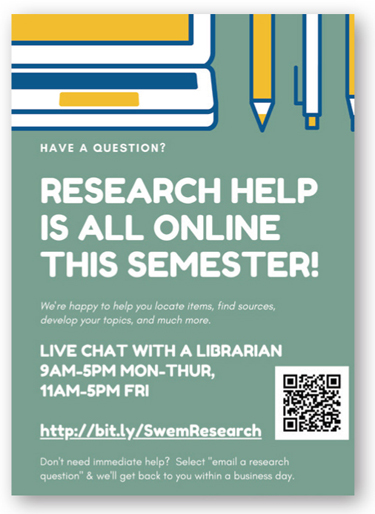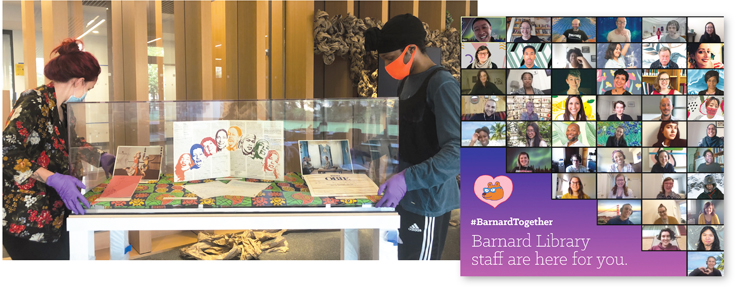How COVID-19 Has Transformed Reference Services for Public and Academic Libraries
Whether librarians are providing services in-person or virtually, reference has changed with the pandemic.
 Bizarre questions are all part of a day’s work for a reference librarian. For Tina Princenthal, senior librarian, InfoNow, at Los Angeles Public Library (LAPL), some of the questions she’s gotten in the last couple of months—can you help me identify a strange herb in my produce box? How much did a Webster’s dictionary weigh in 1860?—were challenging, yet also reassuring. Shortly after LAPL closed its physical locations in March in response to the COVID-19 pandemic, most reference questions focused on the practical basics, such as how to find resources or check out books—but lately, the queries have returned to the unusual. Princenthal observes, “This is how you know that people are feeling more comfortable: We’re seeing weirder and weirder questions.”
Bizarre questions are all part of a day’s work for a reference librarian. For Tina Princenthal, senior librarian, InfoNow, at Los Angeles Public Library (LAPL), some of the questions she’s gotten in the last couple of months—can you help me identify a strange herb in my produce box? How much did a Webster’s dictionary weigh in 1860?—were challenging, yet also reassuring. Shortly after LAPL closed its physical locations in March in response to the COVID-19 pandemic, most reference questions focused on the practical basics, such as how to find resources or check out books—but lately, the queries have returned to the unusual. Princenthal observes, “This is how you know that people are feeling more comfortable: We’re seeing weirder and weirder questions.”
For academic and public librarians alike, handling reference services during a pandemic has been tough, with challenges such as maintaining work-life balance and dealing with a high volume of queries. Princenthal says, “There’s been a steady increase in email reference since March. We’ve grown from an average of 70 emails daily to nearly 200 emails. For instance, in July, we answered 4,681 emails.”
But librarians are meeting these problems head-on. “How do we provide comprehensive, personal responses to each email when you have 60 emails to answer?” asks Princenthal. She and her colleagues have slowed down and gotten to know their resources well, so that when a patron has a question, librarians already know where to start.
Princenthal also says that librarians are now trying to make their emails as comprehensive as possible, adding links, videos, and screenshots where applicable. In the past, librarians would respond with instructions and tell patrons to call if they still were having trouble. “We don’t have that option right now, because we don’t want to overload the librarians,” she says. It’s been a balancing act, however, as librarians attempt to give thorough responses that don’t overwhelm patrons.
 |
VIDEO REFERENCE Neale Stokes (l.), Librarian III, Digital Content Team, and Tina Princenthal, Senior Librarian, InfoNow, take part in one of Los Angeles Public Library’s weekly streaming “Ask a Librarian” videos. Photo courtesy of LAPL |
THE IMPORTANCE OF COMMUNICATION
Candice Benjes-Small, head of research at William & Mary Libraries, Williamsburg, VA, says that communication is more important than ever when it comes to virtual services. “Sometimes users, if they didn’t get an immediate response on chat, they thought we weren’t there and they would drop off. We didn’t see that as much beforehand,” she says. In response, the library’s chat function added an automatic message to let users know that librarians were helping other patrons.
In the past, at Longwood University, Farmville, VA, librarians scheduled one-on-one meetings with students who needed assistance. That hasn’t changed, but the directions on the librarians’ research appointment pages have become even clearer now that there are so many ways to meet. Jennifer Beach, research and instructional services librarian and assistant professor at Longwood’s Janet D. Greenwood Library, notes, “Mine says if you wish to meet through Zoom, I will send you the link. If you wish to meet by phone, you will call me at this number.”
FACE-TO-FACE INTERACTIONS
While most libraries ask patrons to use virtual reference services, some have been interacting in person—with safety measures. At Longwood University, the library encourages students to use virtual services, but if students choose to walk in they’ll be required to wear masks and librarians will take them to a space where they can speak face-to-face while remaining at least six feet apart.
Darien Public Library, CT, is using a similar model. Brittany Netherton, head of knowledge and learning services, says, “For those moments when we need to show them a resource online, we’ve set the reference desk up so patrons can sit on the other side of our Plexiglass and we can duplicate our screen to another monitor for them to see. As for questions involving the physical collection, we’re still taking patrons through the stacks and pulling materials for them; we just do so from six feet away.”
Videos offer patrons an opportunity for face time with librarians without health risk. At LAPL’s “Ask a Librarian Live,” hosted on YouTube, each week different librarians focus on a topic such as science, information literacy, and genealogy, and patrons can ask questions and comment via a text chat feature. One week, when Princenthal was discussing how to access e-media, a patron asked about downloading ebooks for his Kindle. She segued into ebooks, and he told her he had downloaded a book, then left. “I joked, ‘My job here is done,’” says Princenthal.
Miriam Neptune, director of teaching, learning and digital scholarship and interim co-dean at Barnard Library and Academic Information Services, notes that at Barnard College, NY, librarians have created instructional videos that will be available on their online profiles. “It will help to at least break the ice a little,” she says, allowing students to meet librarians before seeing them in instructional meetings or one-on-one consultations.
 |
FORGING AHEAD, SAFELY Though the Darien Public Library prioritizes remote reference, during Hurricane Isaias its reference area still attracted patrons, who safely made use of the library’s services (top). Photo courtesy of Darien Library |
PROVIDING MORE THAN INFORMATION
Though meeting patrons’ informational needs is key, addressing their emotional concerns is important, too. Princenthal reports that right after LAPL shut down its physical locations, many patrons reached out, worried about who would be watering the library community garden; another missed seeing a poster on the wall every day in their local branch and wanted to be reminded of what it looked like. “Those were the questions that were really unique and challenging,” Princenthal says, as they required librarians, who were working from home, to do some digging.
At Cornell University, Ithaca, NY, librarians have fielded similar questions from students missing the campus—which, along with questions about rapidly changing procedures and policies, was part of why the university switched from relying on partner libraries in their chat cooperative to ensuring more questions were handled in-house (see “Expanding Chat Reference During COVID-19 | Peer to Peer Review,” bit.ly/LJCornell). In mid-March, the university formed a Virtual Reference Response team, and between March 18 and May 26, 75.3 percent of chats were answered by Cornell librarians (by comparison, during that same period in 2019, only a little over 50 percent were answered by Cornell staff).
“We felt and still feel that an understanding of the ebbs and flows of campus life at Cornell makes the virtual reference experience more personal and meaningful to the students and staff,” says Rob Kotaska, reference desk and map room coordinator, research and learning services, Olin Library. “They could ask (and did) if the cherry blossom trees on the south side of Olin Library were flowering. Not only would the students’ questions be understood but they could usually get an answer.”
 |
GOING VIRTUAL A flyer promotes virtual services at William & Mary |
“REFERENCE SERVICE REMAINS A TEAM SPORT!”
To ensure that Cornell staffers could handle most of the queries, the university reached out to librarians with frontline reference experience; Cornell brought 16 additional “chatters” into the fold. Because not all were familiar with virtual reference, Kotaska says, “We paired all new chatters with an experienced partner. The internal chat feature for staff has been a wonderful resource for everyone providing chat reference. It’s no different from in-person in that respect—no one has all the answers. Reference service remains a team sport!”
Other library employees also stress the importance of collaboration. Jing Si Feng, information commons assistant division manager at Brooklyn Public Library, notes, “Not all staff working remotely can access our circulation system when assisting patrons with accounts, holds, and returns. For those who can’t, they have to request help from another staff [member], thus adding another layer of internal communication in order to assist patrons.” Over time, however, the librarians have adjusted: “We have a good rhythm now and are able to help patrons pretty quickly.”
At DePaul University Library, Chicago, previously only the reference and research help instruction team handled chat reference. Aware that the library would be fielding many more questions about course reserves, the team invited the access services department to help out. “In the past, when someone had a question about fines or reserves, we’d talk to the access services department, but it wasn’t part of the workflow. The pandemic provided us with a way to integrate them,” says Heather Jagman, coordinator of reference, instruction, and academic engagement and liaison to the Theatre School and College of Education at DePaul University Library. Given the increase in chat queries (from August 9 to September 9, the reference team saw about 875 chat queries, compared with roughly 275 during that period in 2019), collaboration has been beneficial.
Jagman adds, “Not only has it been a great way to serve our patrons, chat also gives us a back channel to talk with each other. So I can ‘see’ my colleagues in access services and say hello.”
At Darien Public Library, on-site staffers and those working from home hand off responsibilities to one another, making for more efficient reference work. “If staff on the physical reference desk need to be free to move about the library and focus on in-person interactions, we can assign the phones and emails to someone who is working from home, and they can be up and running in a matter of seconds,” says Netherton. “That level of adaptability has been key in the last few months.”
TIME MANAGEMENT
Schedules have become more unpredictable during the pandemic; accordingly, many academic libraries have adjusted their virtual reference hours. When K–12 schools physically closed, many students and workers alike had to shoulder the burden of childcare, so Cornell made its virtual chat available during weekends and evenings. Leah Dodd, lead librarian for research services, Olin Library, also notes, “We heard from some students that they were working during the day to help out with household expenses, and we hoped that more hours would be useful to them.” Given that closed campuses mean that college students may be logging in from all over the country, additional hours are helpful to those in different time zones.
But it’s just as crucial that students and patrons be aware of the demands on librarians’ time. Sierra Laddusaw, assistant professor and curator at Texas A&M University Libraries, College Station, observes that sometimes she’ll sign off on a Friday and check email on Monday only to find five or six messages from someone who needed help. While assisting students is important and it can be frustrating not to receive an answer right away, she stresses that downtime is important, too.
Benjes-Small often tells colleagues, “There really are no library emergencies. It’s OK for these things to wait a little bit. This is definitely a marathon, not a sprint. While we could be checking email…all the time, that would not be beneficial to our psychological or mental health.”
Princenthal says that providing virtual reference services can be as taxing as the in-person equivalent. She advises taking frequent breaks; responding nonstop to emails would be “just as chaotic as if you said I’m going to sit at the reference desk and help one person after another for an hour.”
With furloughs making employees’ time an increasingly limited resource, librarians have had to make tough decisions about what services to prioritize. At Barnard College, part of Columbia University, many members of the library staff experienced furloughs over the summer. Neptune says that Barnard set up a chat reference and put it on the library’s site, but had almost no takers, as most students chose to use Columbia’s more well-known service. “I think we probably put in about 150 hours of waiting for people to come and talk to us, and it didn’t happen. Nobody really knew that the chat was there.” Barnard librarians stopped offering and promoting the chat, but it nevertheless provided a lesson in time management as librarians decided to devote time to the services most of use to staff and students.
 |
STILL CONNECTED Despite a pandemic, Barnard College librarians persevere. Curator Souleo and exhibit designer Vanessa Thill (Barnard ’13) (left set up an exhibit devoted to playwright Ntozake Shange. A promotion (right) emphasizes that while the library is closed to students and professors, staffers are still offering services. Photo courtesy of Barnard Communications |
THE ROAD AHEAD
Though librarians have more than stepped up to assist patrons, the pandemic is far from over and work remains to be done. So much reference is still virtual, but not everyone has the same access to technology—and that’s something Neptune wants to work to address. “Librarians have always been great at that. We are the people who notice that not everyone has access to a computer, not everybody has great Wi-Fi,” she notes. Though there are no easy answers, it’s a question that she wants to continue grappling with.
Princenthal cautions librarians to keep cybersecurity in mind. “The InfoNow department has received more phishing scams than we ever have before,” she says. At LAPL, staff responding to emails are reminded not to click links or open attachments but instead ask patrons to describe what they’ve attached; several realistic-looking emails have turned out to be dangerous. “No matter how big or small your library system is, cybersecurity is really important, because people know that everyone’s transitioned online,” Princenthal says.
Netherton advises adaptability. “An event that requires a complete restructuring of your service model is not the time for ‘this is how we’ve always done it.’ This can be difficult, especially if you’ve worked hard in the past to get a certain process to work well, but any process or policy that is too rigid to fit into the ‘new normal’ must be examined and changed.”
Netherton also notes that though it’s been several months since libraries and other institutions moved to virtual models, both librarians and patrons are still confronting hardship. “Remember that we’re all experiencing a trauma together. Interpersonal communication can be difficult even in the best times,” she says. “There are so many terrible things happening to us and around us, and everyone processes differently. Approaching everything from a place of empathy is so important right now.”
Correction: A quote from Rob Kotaska erroneously referred to cherry trees flowering on the Cornell campus; the quote has been updated to indicate that these were cherry blossom trees.
RELATED
ALREADY A SUBSCRIBER? LOG IN
We are currently offering this content for free. Sign up now to activate your personal profile, where you can save articles for future viewing









Add Comment :-
Comment Policy:
Comment should not be empty !!!